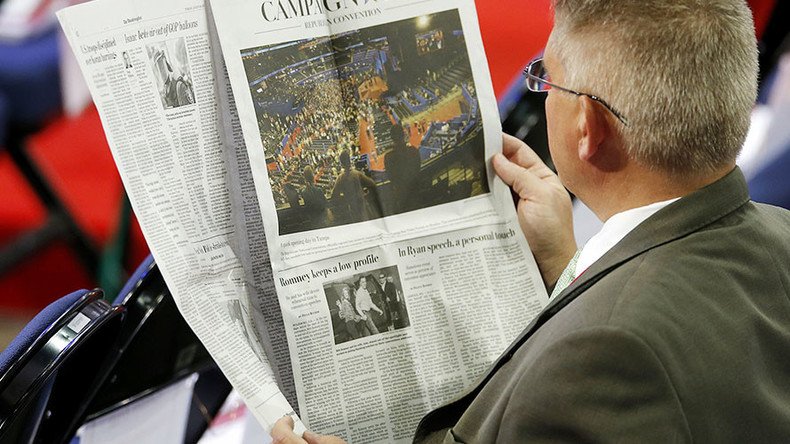The Washington Post teaches us how to make fake news go viral

The Washington Post has the temerity to accuse other news outlets of creating “fake news.” In reality, the paper from the Potomac is a skilled purveyor of the black arts itself. And it has once again proved its proficiency.
So, get this. Last week WaPo ran a whopper, based on an anonymous source and the testimony of a few online trolls, that labeled dozens of unconnected - and ideologically disparate - news organizations and online blogs as part of a “sophisticated Russian propaganda campaign” designed to “undermine faith in American democracy.”
Furthermore, there were calls for blacklists and allusions to how numerous writers and journalists are apparently traitors. Nevertheless, it was the kind of nonsense that anyone who’d spent more than a few days in a decent journalism school could debunk fairly rapidly.
Notwithstanding this, the Post published regardless. And it's hard to understand what its editors were thinking. They've used a very dodgy website used to justify the defamation of 200 news organizations as "Russian agents" with all the negative connotations that branding has in America. To heighten the shambles, WaPo staffers also failed to contact any of the vilified outlets before they published their story.
Many years ago, there was a newspaper I knew which, in a drive for market share, invested heavily in ‘star’ columnists and reporters to establish itself in a then-lucrative market. The problem was that most of them, content with fat pay checks, were both lackadaisical and rather useless. Thus, some terribly inaccurate - or frankly contrived - waffle regularly got into the product.
Please read @mtaibbi on WPost's journalistic disgrace- one that, revealingly, was applauded by countless journalists https://t.co/KvSNQs0r28
— Glenn Greenwald (@ggreenwald) November 29, 2016
The fact it was a Sunday title made matters even worse. Because it turned out that Monday editions of the dailies, produced by a skeleton weekend staff, had even fewer scruples. Thus, apathetic hacks across town simply ‘lifted’ copy from the day before, ensuring that plenty of the baloney found a wider audience.
Back then, it was regarded as questionable content, albeit with worrying ethical implications. Yet, a sort of informal omertà appeared to decree that as long as no significant harm was done, it could be overlooked. Plus, as a lowly freelance, I certainly had no outlet to expose such nefarious practices in the pre-WordPress days.
Anyway, with Facebook restricted to Mark Zuckerberg’s Harvard dorm and Twitter a glint in the milkman’s eye, innocuous celebrity tittle-tattle had limited range. But it’s different now. In the age of the World Wide Web, we live in a time when bad eggs can do considerable damage by spreading “fake news.”
New tools, old ideas
For instance, there are folks making six-figure sums from concocting trash like “Pope Francis shocks world, endorses Donald Trump for president” and “FBI agent suspected in Hillary email leaks found dead in apparent murder-suicide.” Naturally none of these are remotely true, but they’ve spread like wildfire across Facebook, and the omnipresent internet giant has done little or nothing to tackle them. Indeed, I’ve seen London pub landlords make a greater effort to silence conspiracy theory-wielding drunks across bar counters.
Given that social media has been overwhelmingly contaminated by this practice, you’d hope there’d be a fail-safe somewhere in the system. A kind of panic zone to rescue us from “fake news” and present us nourishing spoonfuls of only the truthful stuff. And the most obvious candidates for this role would be members of the establishment press. Hence, outlets like The Independent, Associated Press, The New York Times and USA Today would immediately spring to mind.
However, it appears these entities are also in the business of “fake news” right now. Which greatly complicates matters. And, somewhat amazingly, the once acclaimed Washington Post is leading the way. Right now, poor Dustin Hoffman and Robert Redford must be inconsolable.
Holes in one
You see, the WaPo report, citing the research of a thing called “Prop Or Not” (the Twitter account of which, only set up in August, is fond of tweeting out WW2 Ukrainian nationalist slogans) had more holes than Augusta National Golf Club.
Wow. The @washingtonpost anonymous source for blacklisting US journalists recently tweeted 1940s Ukrainian fascist "Heroiam Slava!" salute pic.twitter.com/vGvhAIjgTl
— Mark Ames (@MarkAmesExiled) November 26, 2016
As a result, its premise was quickly torn to pieces by talented journalists like Glenn Greenwald, Ben Norton, Matthew Ingram, Matt Taibbi and Yasha Levine.
Indeed, The Washington Post itself has already added two clarifications to the original text at the request of this network. Those corrections are due to RT being wrongfully accused of generating fake stories and using a #CrookedHillary hashtag promoted by Donald Trump.
Yet, despite this thorough discrediting of WaPo’s fictionalized report and the fact that proper news people and Russia experts have rubbished it, the fabrication has gone viral across the popular media. And the list of organizations who have spread it is mind-boggling.
It’s time for editors at The Independent, Chicago Tribune, Daily Mail, Associated Press, USA Today and The New York Times to take a dishonorable bow. Because they have all, without proper examination, spread WaPo’s ‘fake news’ this week.
In fact, only USA Today even remotely considered the possibly that they’d all been hoodwinked by referencing an RT editorial which punctured the balloon. Meanwhile, Mediaite - a relatively influential press affairs site - went the full Joseph McCarthy by more-or-less smearing Ed Schultz and Larry King, both associated with RT America, as treasonists.
No ramifications
Now, I’ve a really good theory for why the purportedly proficient professionals at these allegedly authoritative organs dirtied their bib. That’s because they simply don’t care. You see, I’ve been following media coverage of Russia for long enough now to realize how nobody has ever suffered grievous career consequences for being hopelessly wrong about the country.
You can literally accuse “the Kremlin” of anything and get away it. “Vladimir Putin is hiding a $200 billion fortune” (WaPo again!), “Russians are in contact with Aliens (The Daily Express) “Putin’s about to invade Europe” (Newsweek, this week!) or “Sergey Lavrov Ate My Hamster.” Okay, that last one actually hasn’t happened yet but is probably in the pipeline somewhere.
Right now, the narrative is “fake news” and Russia’s alleged part in it. However, when I personally think of made up stories which caused genuine and lasting damage, it’s the infamous Iraq ‘Weapons of Mass Destruction' pretext that springs to mind. And which media concern did more than basically any other to promote this falsehood? Why it was The Washington Post, with an incredible 140 front page stories, and 27 editorials pushing for America’s illegal invasion, which left close to one million people dead and continues to leave a trail of destruction across the Middle East.
Now, that sort of “fake news” is far from harmless, isn’t it? In fact, it's clear how The Washington Post has been showing us how to make phoney reportage go "viral" for years.
The statements, views and opinions expressed in this column are solely those of the author and do not necessarily represent those of RT.













